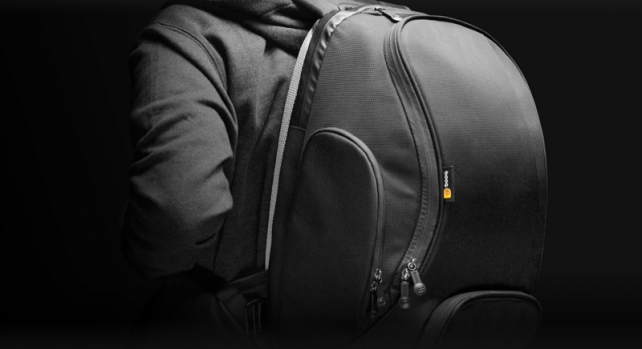![]()
If there’s one thing the digital age has helped, it’s access to media—particularly music. If you’re anything like me, you carry your tunes with you on your iPhone so you can rock out whenever the need strikes. While it’s easy and convenient to just put all of your music on your phone, if you want it to sound awesome, you need to have awesome speakers. That’s the catch-22 of listening on a smartphone: Users want a pocket sized package, but speaker efficiency and fidelity demands bigger packages. Up to this point in time, we basically had three options:
- Live with the low volume of the built-in speakers
- Get a set of headphones
- Connect the phone to some sort of active amplifier and speaker system
Each has its pros and cons. Obviously option one doesn’t get any improvement in volume, but it’s also convenient, ultra portable, allows you to listen to ambient noises, and doesn’t require staying close to an amplifier/speaker. Option two gives you very good quality sound, but at the expense of reducing ambient noise. Option three is an excellent choice for a stationary situation such as an office or kitchen; but lugging around even the smallest external amp/speaker is not something you’d want to do on a daily basis, and naturally they also need a power source, either via battery or a wall outlet.
The fine folks at XL4D have been subject to the same tradeoffs as the rest of us, but they decided to do something about it: armed with a 3D printer, they designed a suite of plastic cases and stands that take the built-in speaker and make it better.
If you’ve ever gone to a concert venue and taken a look at the sound reinforcement, you’ve undoubtedly seen a horn speaker. These look just like the bell of a horn, and what they do is focus the sound energy directionally while also greatly improving efficiency. “Horn-loaded” drivers can basically do more with less, which is exactly what XL4D has done with their ingenious designs.
All of the available products from XL4D are completely passive, and made of one piece of 3D printed plastic. The company claims that the designs are complex enough to make the traditional injection molding process problematic, and that using 3D printers allows them the flexibility they need. I can definitely say that there’s high quality and accuracy—they feel solid and very tough, and fit my iPhone 5s case perfectly.
There are two different stand designs. The first is the Lotus 5 ($26.99) which holds the phone in a portrait orientation, while its counterpart the ToneStand 5 ($55) is for landscape. It’s unfortunate that you have to choose which one you want, but each is optimized for that particular orientation. I found the landscape version slightly more versatile, but portrait would be perfect if you spend a lot of time using your phone for FaceTime or other video conferencing.
Of course, they make excellent stands in and of themselves, holding the phone at an angle that's convenient for viewing, but what makes them cool is the integral horn that's molded in. The entrance of the horn is positioned right over the phone's built-in speaker and channels the sound waves out to the front of the phone.
The final design I was sent to review is the ToneCase 5 ($39.95). Which is more like a traditional phone case instead of a stand. Similar to the two stands it also has an integral horn built in, but it is a lot less bulky and is designed to be left on the phone 24/7. As far as cases go, the strength of the plastic seems like it would serve well to protect the phone from impact, but it does not have a screen protector so you'll have to use your own to guard against scratches on the face. It is relatively compact and only adds a small amount of bulk. In fact I found the phone easier to hold with my hand or my shoulder during a call.
There are two versions of the case-style product: the Voice and the Omni. The Voice has a small “funnel” for the phone's microphone that increases its directionality and focuses it towards your mouth as you hold the phone to your ear. This reduces background noise and improves the voice quality for your caller. The Omni version doesn't have this feature, because that directionality is pointing the wrong way for picking up audio via movies! So if you find yourself frequently whipping out your phone and capturing videos, you'd probably want to go for the version without the microphone horn. It'll work either way, but each one is optimized for a different use, so keep that in mind.
Let me tell you—these cases work! The effect of the horn is immediately noticeable. With all three designs, instead of the sound coming out of the side (or bottom in portrait orientation), it projects right towards your face as you look at the phone screen. It is definitely louder and more focused, and works particularly well with voices.
Since I was sent the case with the microphone horn, I did two tests to see if it made a difference, and with the case on it made a small but noticeable improvement in the ability of the person on the other end of the line to hear me over background noise (I used a TV). I also took a short video and the mic still picked up the subject, but in this situation it was a bit of a problem. Of course you can quickly remove the case if the audio is that important!
All three cases are simple, one-piece designs with no moving parts and they require absolutely no additional power to use. They are inherently waterproof (though your phone certainly isn't), compact, and serve multiple purposes: protection, convenience, and sound reinforcement.
I give all three cases five out of five stars. They do what they are meant to do and they do it well.
![]()
![]() The game begins by asking you to use headphones, then takes you to a scene outside a record store where your character loses his box of records due to a near run-in with a car. In order to retrieve the records and gain entry into the club, you have to successfully avoid all the obstacles on your run throughout the city scene in time with the beat of the song you pick. This is done by swiping up, left, right, and down on your screen at key points. Your score then determines the amount of stars you'll be awarded for the song as well as if you'll get any backstage passes, which serve as valued currency to progress through the game.
The game begins by asking you to use headphones, then takes you to a scene outside a record store where your character loses his box of records due to a near run-in with a car. In order to retrieve the records and gain entry into the club, you have to successfully avoid all the obstacles on your run throughout the city scene in time with the beat of the song you pick. This is done by swiping up, left, right, and down on your screen at key points. Your score then determines the amount of stars you'll be awarded for the song as well as if you'll get any backstage passes, which serve as valued currency to progress through the game. 






 Verizon's LTE network was already pretty speedy, and now the company has
Verizon's LTE network was already pretty speedy, and now the company has 






















































